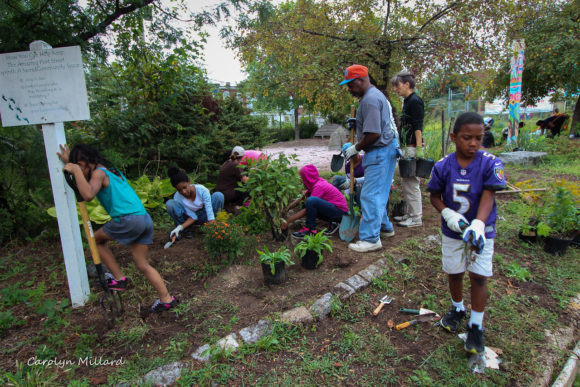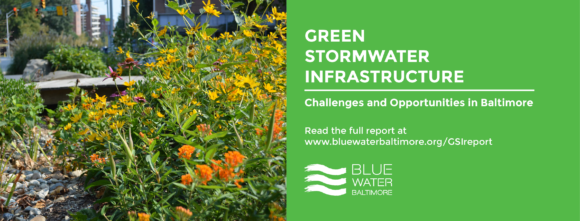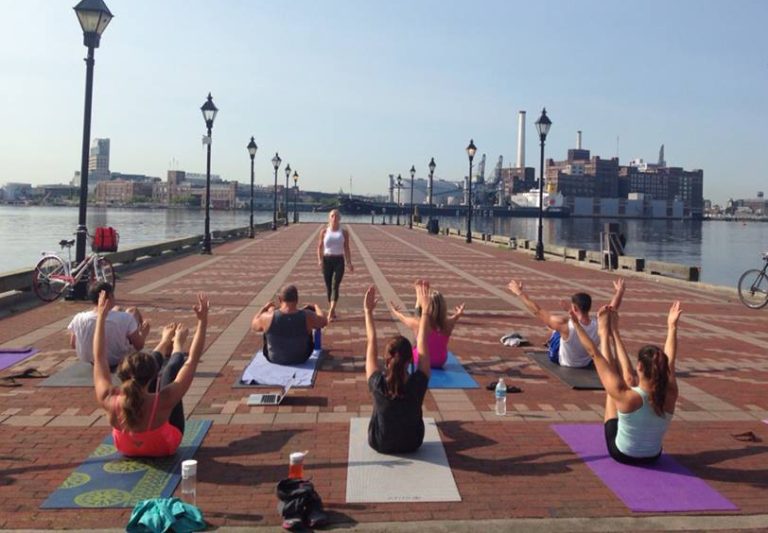Barriers to Green Stormwater Infrastructure in Baltimore
ENVISIONING A STRONGER CITY
Green Stormwater Infrastructure (GSI) is the practice of treating and replacing impermeable hardscape, like roads and roofs, with plant-based and water harvesting systems. Rain gardens, trees, rain barrels, and permeable pavers are all examples of GSI that you can see throughout Baltimore City. GSI reduces the volume of stormwater, slows its flow, and makes it easier for stormwater to soak into the soil, instead of running off into our storm drains and waterways.

Nearly half of Baltimore’s landscape is made up of concrete, asphalt, and other impermeable hardscape that prevents rain from soaking into the ground. Every time it rains, trash, bacteria, heavy metals, and other pollutants are washed from city streets and roofs into local streams and the harbor. Stormwater has negative environmental, economic, and public health impacts on the city and its residents. Stormwater pushes high bacteria loads into waterways, causes sewage back-ups in homes, floods streets, and can cause consumption advisories for local fish and crabs. GSI is an important tool to improve water quality, combat flooding, and reduce stormwater runoff while achieving many co-benefits.
GSI doesn’t just improve the environment – it is also credited with fostering community, improving mental health, making cities cooler during hot summer months, and improving air quality. But despite these numerous benefits, GSI is still not very common in Baltimore City. So what’s the hold up, you ask? Last year Blue Water Baltimore issued a report outlining just that. We concluded that there are three main challenges to creating Green Stormwater Infrastructure in Baltimore City, and we have suggestions and potential solutions for how they can be overcome.

CHALLENGE #1: UNCLEAR GUIDANCE AND PERMITTING FOR VOLUNTARY GSI
The city code does not include a standard process for voluntary GSI. Most GSI projects in Baltimore are required as part of large-scale development, and they must follow strict regulations and permitting. These same guidelines should not be applied to community-led greening projects, because the scale and scope is typically much smaller, and more importantly, voluntary. City code should be updated to include voluntary GSI so that community groups have a streamlined process for approval.
CHALLENGE #2: POOR COMMUNICATION AMONG CITY AGENCIES AND WITH RESIDENTS
Currently, GSI regulation is managed by the Department of Public Works (DPW). Efficient GSI implementation would include collaboration and communication between multiple City departments and with residents and stakeholders. Blue Water Baltimore would like to see a collaborative GSI Task Force, composed of relevant city agencies and external stakeholders. By bringing together different sectors to share responsibility and ideas for stormwater management, the city could break down silos and allow Baltimore to better recognize the environmental, public health, and community benefits of GSI.
CHALLENGE #3: INSUFFICIENT FUNDING FOR GSI
Baltimore City has a dedicated fund for stormwater remediation through the Stormwater Utility Fee, yet much of the fund is spent on general operations like street sweeping, with very little being allocated to GSI. Using ratepayers’ stormwater payments to fund existing city services robs Baltimoreans of the opportunity to benefit from transformative GSI projects. The City should substantially increase the portion of Stormwater Fee revenue that supports Green Stormwater Infrastructure.
Ultimately, Blue Water Baltimore recommends updating the City Code to include guidance for voluntary GSI, creating a multi-agency GSI Task Force, and increasing the use of the City’s Stormwater Utility Fee revenue to fund GSI projects. Blue Water Baltimore hopes that our report will encourage Baltimore City officials to do more to support green infrastructure and reap its benefits. You can read the full report on our website.
This report was made possible with support from the Pisces Foundation, the JPB Foundation, and the Abell Foundation. To read the full report, please visit our website.



